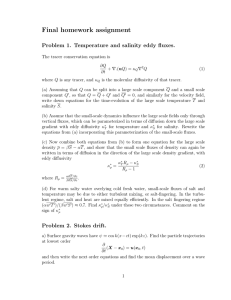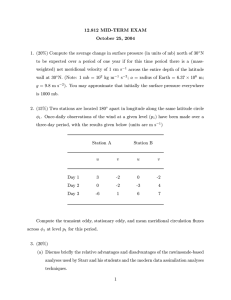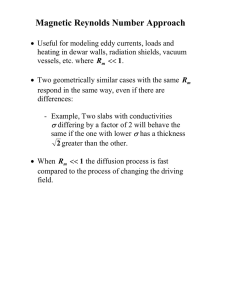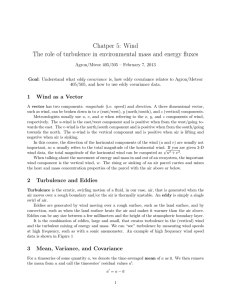Determining the high-frequency performance of eddy covariance
advertisement
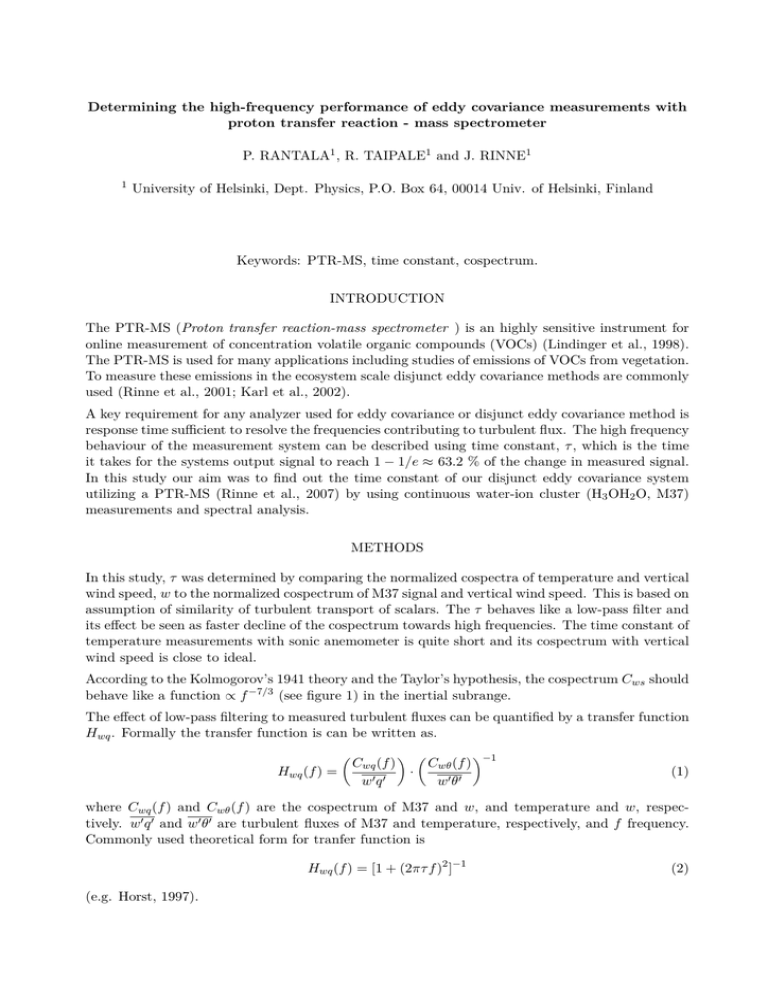
Determining the high-frequency performance of eddy covariance measurements with proton transfer reaction - mass spectrometer P. RANTALA1 , R. TAIPALE1 and J. RINNE1 1 University of Helsinki, Dept. Physics, P.O. Box 64, 00014 Univ. of Helsinki, Finland Keywords: PTR-MS, time constant, cospectrum. INTRODUCTION The PTR-MS (Proton transfer reaction-mass spectrometer ) is an highly sensitive instrument for online measurement of concentration volatile organic compounds (VOCs) (Lindinger et al., 1998). The PTR-MS is used for many applications including studies of emissions of VOCs from vegetation. To measure these emissions in the ecosystem scale disjunct eddy covariance methods are commonly used (Rinne et al., 2001; Karl et al., 2002). A key requirement for any analyzer used for eddy covariance or disjunct eddy covariance method is response time sufficient to resolve the frequencies contributing to turbulent flux. The high frequency behaviour of the measurement system can be described using time constant, τ , which is the time it takes for the systems output signal to reach 1 − 1/e ≈ 63.2 % of the change in measured signal. In this study our aim was to find out the time constant of our disjunct eddy covariance system utilizing a PTR-MS (Rinne et al., 2007) by using continuous water-ion cluster (H3 OH2 O, M37) measurements and spectral analysis. METHODS In this study, τ was determined by comparing the normalized cospectra of temperature and vertical wind speed, w to the normalized cospectrum of M37 signal and vertical wind speed. This is based on assumption of similarity of turbulent transport of scalars. The τ behaves like a low-pass filter and its effect be seen as faster decline of the cospectrum towards high frequencies. The time constant of temperature measurements with sonic anemometer is quite short and its cospectrum with vertical wind speed is close to ideal. According to the Kolmogorov’s 1941 theory and the Taylor’s hypothesis, the cospectrum Cws should behave like a function ∝ f −7/3 (see figure 1) in the inertial subrange. The effect of low-pass filtering to measured turbulent fluxes can be quantified by a transfer function Hwq . Formally the transfer function is can be written as. Hwq (f ) = Cwq (f ) w′ q ′ · Cwθ (f ) w′ θ′ −1 (1) where Cwq (f ) and Cwθ (f ) are the cospectrum of M37 and w, and temperature and w, respectively. w′ q ′ and w′ θ′ are turbulent fluxes of M37 and temperature, respectively, and f frequency. Commonly used theoretical form for tranfer function is Hwq (f ) = [1 + (2πτ f )2 ]−1 (e.g. Horst, 1997). (2) The measurements were done in Hyytiälä at the SMEAR II measurement station (61◦ 510’ N, 24◦ 170’ E, 181 m. above sea level) during July 3,–4, 2008. H3 OH2 O (M37) was measured with a PTR-MS continuously at high frequency. M37 corresponds to water vapor (H2 O) because the PTR-MS uses hydronium ions (H3 O+ ) to ionize target compounds via proton transfer reactions. The measurement frequency fluctuated between 3.57–4.76 hz with an average value of 4.13 hz and a standard deviation of 0.46 hz. Wind-measurements were done using a 10 hz ultrasound anemometer (Gill Instruments Ltd., Solent HS1199) which measured also a virtual temperature Ts . In this case, ′ ′ it was realistic to assume that Ts ≈ θ . The PTR-MS data was first processed by the calibration procedure by Taipale et al., (2008). Second, the lag time between wind and M37 measurements was estimated by maximizing the cross covariance function of the M37 and wind measurements for every 30 minute measurement period (Taipale et al., 2009). The wind and temperature data was also processed choosing data points which had been measured same time with the M37 data and dismissing the rest. The cospectral densities Cws were calculated using fast Fourier transform (FFT) on the cross covariances of 212 data points and taking their real parts. After that, the normalized cospectra were smoothed into 51 bins and finally, the smoothed spectra were averaged and these were used to determine the transfer function empirically (eq. 1). The time constant τ was determined by fitting the curve described by Equation (2) to empirically determined transfer function (see figure 2). This was done using data within the inertial subrange, 0.05 hz< f < 0.6 hz (see figure 1). The fitting (with 95 % confidence intervals) was determined by using Gauss-Newton algorithm. From this the time constant was determined to be τ = 0.7 ± 0.3 s. Due to the scatter in the data the uncertainty is relatively large. Based on another method , Karl et al. (2000) have estimated approximately 0.8 s as the upper-limit of τ . Thus these estimates are relatively close. CONCLUSIONS We have estimated the response time of our disjunct eddy covariance - PTR-MS set-up using specrtal analysis. Although the response time, τ = 0.7 ± 0.3, is relatively long it is still short enough to capture most frequencies contributing to turbulent fluxes above the forest canopy. The response time derived here is response time for whole measurement set-up and can not be directly applied to different set-ups. Especially the signal attenuation in the inlet tube contributes differently depending on the dimensions of the tube and the air flow in it. Cospectrum of M37 Cospectrum of temperature 2 Normalized cospectrum 10 −7/3 0 10 −2 10 −2 −1 10 10 Frequency (hz) 0 10 Figure 1: Cospectrums of M37 and temperature. The area between dash lines was used for calculating the time constant. Transfer function Curve fitting 95 % interval confidence 1 Transfer function 0.8 0.6 0.4 0.2 −1 10 Frequency (hz) Figure 2: Transfer function Hwq and the fitting. REFERENCES Horst, T. W., 1997: A simple formula for attenuation of eddy fluxes measured with first-orderresponse scalar sensors. Bound.-Layer Meteor., 82, 219Ű233. Karl, T., Guenther, A., Jordan, A., Fall, R. and Lindinger, W., 2000: Eddy covariance measurement of biogenic oxygenated VOC emissions from hay harvesting. Atmospheric Environment, 35, 491495. Karl, T. G., C. Spirig, J. Rinne, C. Stroud, P. Prevost, J. Greenberg, R. Fall & A. Guenther, 2002: Virtual disjunct eddy covariance measurements of organic trace compound fluxes from a subalpine forest using proton transfer reaction mass spectrometry. Atmospheric Chemistry and Physics, 2, 279-291. Lindinger, W., Hansel, A., & Jordan, A., 1998: On-line monitoring of volatile organic compounds at pptv levels by means of Proton-Transfer-Reaction Mass Spectrometry (PTR-MS)—Medical applications, food control and environmental research. Int. J. Mass Spectrom., 173, 191-241. Rinne, H. J. I., A. B. Guenther, C. Warneke, J. A. de Gouw & S. L. Luxembourg, 2001: Disjunct eddy covariance technique for trace gas flux measurements. Geophysical Research Letters, 28, 3139-3142. Rinne, J., R. Taipale, T. Markkanen, T.M. Ruuskanen, H. Hellén, M.K. Kajos, T. Vesala & M. Kulmala, 2007: Hydrocarbon fluxes above a Scots pine forest canopy: measurements and modeling. Atmospheric Chemistry and Physics, 7, 3361-3372. Taipale, R., Ruuskanen, T.M., & Rinne, J., 2009: Lag time determination in DEC measurements with PTR-MS. Atmos. Meas. Tech. Discuss., 3, 405-429. Taipale, R., Ruuskanen, T.M., Rinne, J., Kajos, M.K., Hakola, H., Pohja, T. & Kulmala, M., 2008: Quantitative long-term measurements of VOC concentrations by PTR-MS-measurement, calibration, and volume mixing ratio calculation methods. Atmospheric Chemistry and Physics, 8, 6681-6698.

